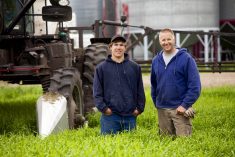Traditionally, farms used family, friends and neighbours to supply labour. However, as family size and rural population has shrunk, and as the size of the average farm has increased, our reliance on hired employees has multiplied.
Today, farms often employ and manage a handful of people, and it’s also not uncommon for those employees to have roles that require more and more skill. “The need for quality employees is increasing across the country,” says Debra Hauer, project manager, Canadian Agricultural Human Resource Council (CAHRC).
This is reflected in the foreign workers program, which is now in use in more provinces and farming sectors. “The number of foreign workers in agriculture has doubled across Canada in the past 10 years,” says Hauer. “In 2013, there were approximately 45,000 foreign workers working on farms.”
Read Also

Riding the tariff rollercoaster
Farmers are accustomed to roller-coaster years. But the current geopolitical windstorm is something else entirely. On his cattle operation near…
Another indicator of current and future employee need is the number of vacancies. According to CAHRC’s report, Labour Market Information on Recruitment and Retention, the primary agriculture sector’s estimated vacancy rate is nine per cent, with three in four employers reporting at least one vacant position in their operation.
That’s more than 25,000 job vacancies for non-seasonal positions across the entire sector, with employers also reporting a 20 per cent vacancy rate for seasonal positions for an additional 16,560 vacancies.
- Read more: Farming. It’s more than a job
Now, it’s impacting farm decisions. Vacancies are forcing farmers to ask questions about quality risks with delayed harvest. They are also having to put aside expansion plans, consider investments in labour-saving technologies, and look at changing crops and livestock in light of their labour requirements.
“What’s it costing your farm to have staff turnover?” asks Hauer.
Farmers who want to test your HR abilities and skills can check out the CAHRC’s on-line self-assessment of occupational standards for farmers/farm managers at www.cahrc-ccrha.ca. From the same website you also purchase and download the AG HR toolkit which provides working templates and valuable information on managing the human side of your farm’s operations.















